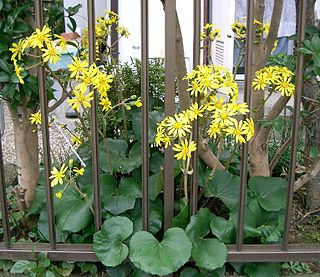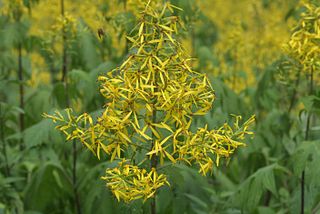
Senecio is a genus of flowering plants in the daisy family (Asteraceae) that includes ragworts and groundsels.

Aequatorium is a genus of flowering plants in the aster family. It was described as a genus in 1978. It is a member of the tribe Senecioneae and native to South America.

Rune Bertil Nordenstam is a Swedish botanist and professor emeritus at the Swedish Museum of Natural History in the Department of Phanerogamic Botany. He has worked with Colchicaceae, Senecioneae and Calenduleae, was the editor of Compositae Newsletter newsletter since 1990, and is a Tribal Coordinator for The International Compositae Alliance with responsibility for the tribes Calenduleae and Senecioneae.

Elekmania is a genus of the tribe Senecioneae and the family Asteraceae. All species are endemic to the Caribbean island of Hispaniola, in the Dominican Republic and Haiti.

Pieter B. Pelser is a lecturer in Plant Systematics and the curator of the herbarium at the University of Canterbury in Christchurch, New Zealand. One research interest is the evolutionary history of the tribe Senecioneae, one of the largest tribes in the largest family of flowering plants. He wrote the most recent attempt to define and delimit this tribe and its problematic founding species Senecio. He also studies insects that eat these plants (Longitarsus) which contain pyrrolizidine alkaloids and what makes them choose which plants they eat.
Caucasalia is a genus of flowering plants in the daisy family.
Cissampelopsis is a genus of flowering plants in the daisy family, native to India, China, and Southeast Asia.

Cremanthodium is a large genus of flowering plants in the daisy family.

Dolichorrhiza is a genus of flowering plants in the sunflower family.

Dolichoglottis is a genus of flowering plants in the daisy family, Asteraceae.

Farfugium is a genus of flowering plants in the family Asteraceae, native to streams and seashores in east Asia. They are rhizomatous evergreen perennials with rounded leathery leaves and bright yellow flowers in autumn and winter. Species include Farfugium japonicum, with variegated cultivars for use in horticulture.

Traversia is a genus of New Zealand plants in the groundsel tribe within the daisy family.
Iranecio is a genus of flowering plants in the sunflower family, native to the eastern Mediterranean east to the Caucasus.

Lasiocephalus is a genus of South American flowering plants in groundsel tribe within the sunflower family. The genus was shown to be part of Senecio and predominantly occurs in tropical alpine-like regions.
Pojarkovia is a genus of flowering plants in the sunflower family.
Synotis is a genus of Asian plants in the groundsel tribe within the daisy family. The species occur mostly in the Himalayan region of southwestern China and the northern Indian Subcontinent, but a few are native to northern China.
Sinosenecio, also butterweed, is a genus of Asian plants in the groundsel tribe within the daisy family. Most of the species are found only in China, with a few extending southward into Indochina.

Sinacalia is a genus of Chinese plants in the groundsel tribe within the daisy family.

Jacmaia is a genus of flowering plants in the daisy family. This generic name is an anagram derived from Jamaica.
Stenops is a genus of African flowering plants in the daisy family.













